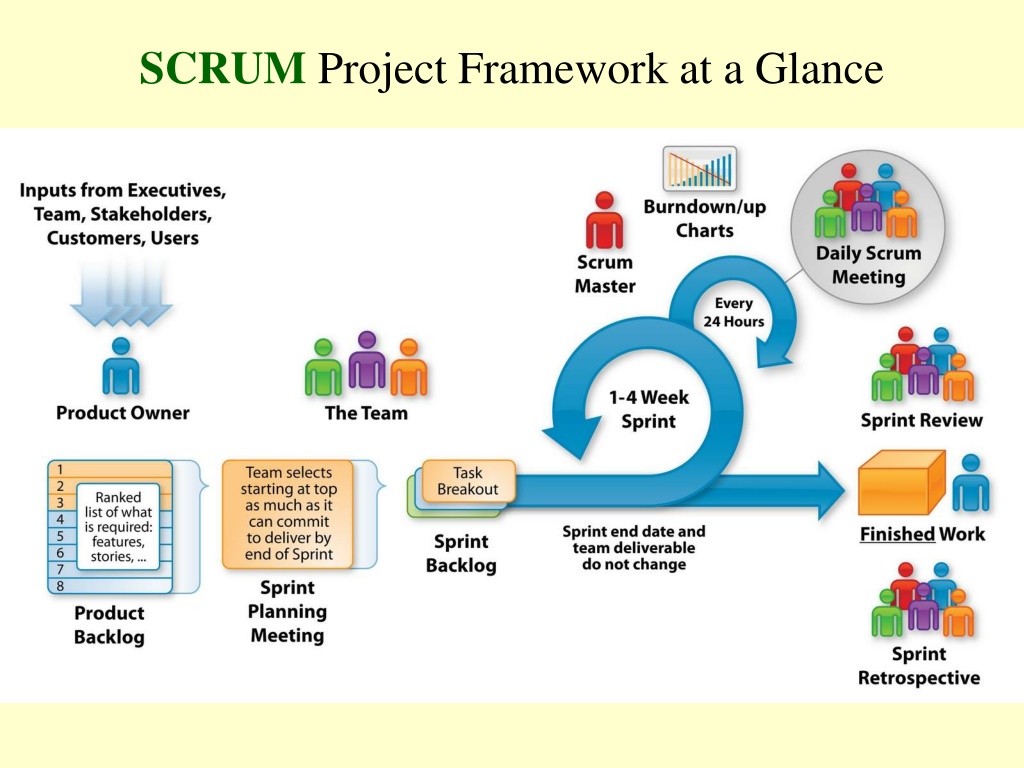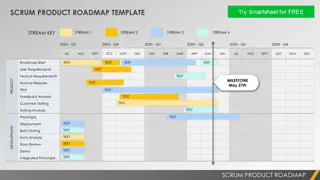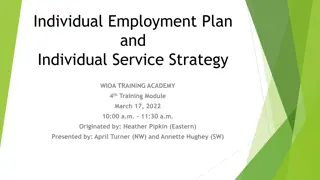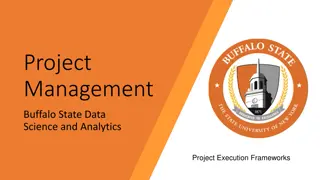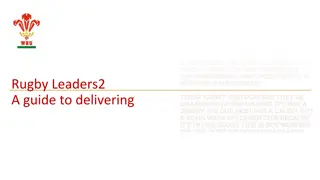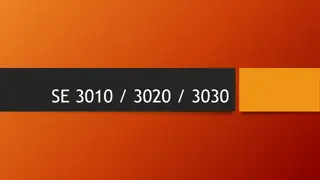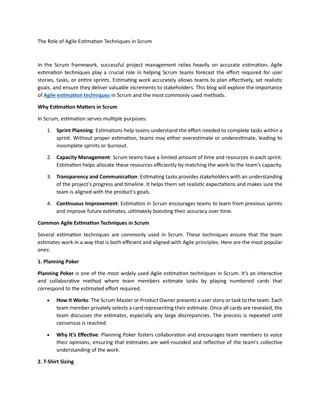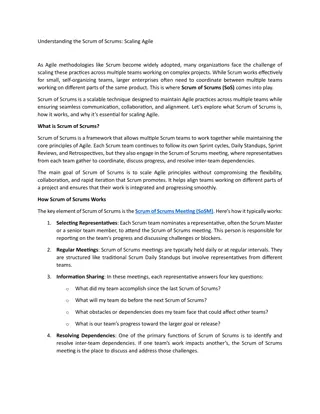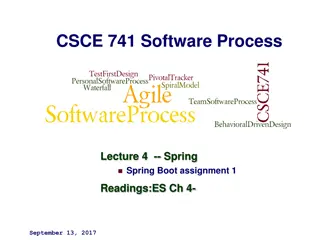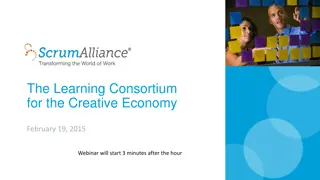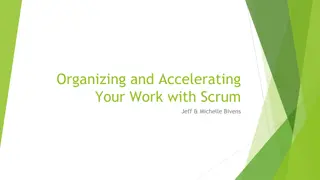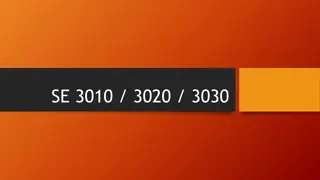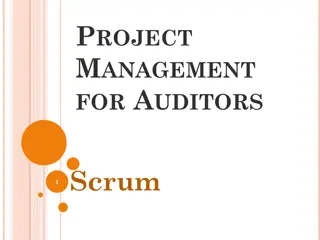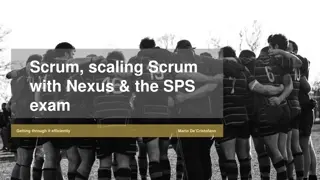Understanding the SCRUM Project Framework and Participants
Comprehensive overview of the SCRUM project framework including SCRUM Sprint framework, key participants such as Product Owner, SCRUM Master, and SCRUM team. Details on their roles, responsibilities, and collaborative dynamics for project success. Emphasis on team effectiveness factors like positive interdependence, accountability, promotive interaction, teamwork skills, and group processing.
Download Presentation

Please find below an Image/Link to download the presentation.
The content on the website is provided AS IS for your information and personal use only. It may not be sold, licensed, or shared on other websites without obtaining consent from the author. Download presentation by click this link. If you encounter any issues during the download, it is possible that the publisher has removed the file from their server.
E N D
Presentation Transcript
SCRUM Sprint Framework at a Glance Sprint Go-live functionality added to the Build Product Owner assesses work completed approval and changes Team assesses work what was learned how could they improve
Participants Stakeholders Anyone affected by the outcome of the project Product Owner Key Stakeholder! Represents all other Stakeholders Has the vision of what is to be built Has thorough understanding of customer needs The Judge of the value to be delivered Prioritizes requirements, defects, and other work items for the team Educates team in the business domain Negotiates priorities, scope, funding, and schedule
Participants SCRUM master Coach and facilitator for the SCRUM team Job is to facilitate communication and problem resolution and ensure maximum value is provided to the customer Ensures the team focuses on goals of the current iteration Removes barriers that block the team so they can deliver high quality software Works with Product Owner, providing a check and balance between getting more done and maintaining high quality and efficiency
Participants SCRUM team (self-organizing) Highly Collaborative Self-organizing Team members posses all the skills needed to create a shippable product Team members collaborate on all the work Team has total authority over how the work is done and which team members work on which tasks The team creates and owns story point estimates The role of each team member is to help the team deliver shippable (go live ready) product at the end of each sprint Shared understanding of what Done means Rule of thumb: 3 to 9 members
Participants SCRUM team effectiveness depends on Positive Interdependence "The team focuses on a common goal or single product Individual and Group Accountability "Each person takes responsibility for both her or his own work and the overall work of the team Promotive Interaction "The members do real work, the standard collaboration is face to face Teamwork Skills "Each member has the skills for and practices effective communication (especially careful listening), decision making, problem solving, conflict management, and leadership Group Processing "The team periodically reflects on how well the team is working, celebrates the things that are going well, and corrects the things that aren't"
Daily Scrum Standup Scrum Master and Team Purpose for the team to understand what each is working on and collaborate and help resolve any impediments they maybe facing Each team member answers the following 3 questions: 1. What you have done since the last standup? 2. What, if anything, is preventing you to perform your task? 3. What you will do between now and the next meeting?
REQUIREMENTS: UserStories and the 3 Cs A Card is used to record each User Story A standard format is As a < user role > of the product I can < action > So that < benefit > A Conversation Elaborative conversations with users are necessary because a user story may be difficult to interpret, some background knowledge could be needed for implementation, or the requirements could have changed since the story was written. Confirmation Acceptance criteria used to confirm that the user story is implemented correctly and successfully delivered. who what why
Airline Registration System FEATURE: User wishes to book a flight USER STORIES: User needs to book a one way flight User needs to specify the number of passengers for this booking User needs to indicate departure airport User needs to indicate date and time of departure User needs to indicate destination airport User needs to know date and time of arrival User needs to book a roundtrip flight User needs to indicate date and time of return departure User needs to know date and time of return arrival
Product Backlog Prioritized list of each Feature and a list of its user stories containing short descriptions of all functionality desired in the product Product Backlog Features/Stories Bugs Technical work Knowledge acquisition Story points are estimated for each Story Represents the effort required to estimate the development work required. In simple terms, Story Points are an estimate of the work required to convert the Story into functionality The amount of work needed could be related to complexity, effort and/or unknowns. To be assigned to each Sprint
Product Backlog Items The team assesses each Backlog item to see if it is doable Is there enough information to complete? Is it small enough to estimate? Is there a definition of done ? Each item must be demonstrated and shippable.
Sprint Planning Filling the Iteration/Sprint Backlog Team plans for the Sprint Sprints are a fixed length of time (usually 2 to 4 weeks) The number of Story Points that can be completed in one iteration is estimated the represents an estimate of the team s sprint velocity. The team selects the highest priority Stories from the Product Backlog The sum of the Story Points for these stories must be less than or equal to the team s estimated velocity Only the team converts each Story into the development tasks Team determines who will be assigned to which task or tasks Current status of the work is recorded on the Team sTask Board
The work and the Definition Of Done (DOD) An example of a set of done criteria: Code is peer-reviewed Code is deployed to test environment Feature is tested against acceptance criteria Feature passes regression testing Feature passes smoke test Feature is documented Feature frontend and backend work is complete and fully tested At the end of the sprint, the Product Owner assesses the work and makes change requests if needed.
Sprint Task Board in Use During an Iteration High level tests for the Story Work In Progress 8+5+6+5+4+4 = 33 Tasks Tests Ready Hours Remaining Story To Do To Verify Hours As a user, I can Code the Code the SC 5 Code the LC 4 8 33 5 Code the Code the DC 4 5 Story Points Developers initials Test the 6 As a user, I can 13 Code the 8 2 Code the 5 As a user, I can 13 Code the Code the MC 4 3 3 Code the 6 One row for each story
Sprint Review Meeting Open meeting Anyone can come Product Owner, Scrum Master, the team, Stakeholders, Management, customers . Team demonstrates all that was Done Product Owner reviews what was Done and may Accept or reject the feature Point out a deficiency or bug Suggest changes that are needed Partially completed features are scheduled during the next spring planning meeting.
Sprint Retrospective Meeting The team assesses the work that was done What processes or practices went well and what processes or practices need to be improved? Do smaller tasks work better than large ones? Is the definition of done need to be clearer? Do all team members have access to the current status during the iteration? Goal is to improve on the processes and practices in the next iteration Improve the Sprint velocity
Release Planning Meeting A project consists of a number of iterations (sprints) A release consists of a subset of iterations The purpose to go through the backlog and give an estimate of the number of priority features that can be completed after a subset of iterations Provides Management and the Product Owner with information on the expected value to be delivered and the expected number of iterations required
Burn down charts are a graphical representation of work left to do versus time. Iteration Burndown Chart Story Points Ideal completion rate Story Points remaining Sprint
Meet The U.S. Digital Service The United States Digital Service is transforming how the federal government works for the American people. And we need you. JOIN US 23
